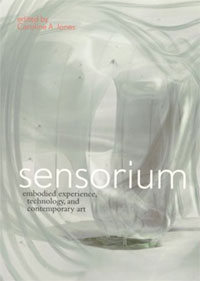 Sensorium. Embodied Experience, Technology, and Contemporary Art, edited by Caroline A. Jones, Director, History, Theory and Criticism of Architecture and Art and Professor of the History of Art at MIT (Amazon UK and USA)
Sensorium. Embodied Experience, Technology, and Contemporary Art, edited by Caroline A. Jones, Director, History, Theory and Criticism of Architecture and Art and Professor of the History of Art at MIT (Amazon UK and USA)
Publisher MIT Press says:The relationship between the body and electronic technology, extensively theorized through the 1980s and 1990s, has reached a new technosensual comfort zone in the early twenty-first century. In Sensorium, contemporary artists and writers explore the implications of the techno-human interface. Ten artists offer their own edgy investigations of embodied technology and the technologized body. These range from Matthieu Briand’s experiment in “controlled schizophrenia” and Janet Cardiff and Georges Bures Miller’s uneasy psychological soundscapes to Bruce Nauman’s uncanny night visions and François Roche’s destabilized architecture. (…) Artwork by each artist appears with an analytical essay by a curator, all of it prefaced by an anchoring essay on “The Mediated Sensorium” by Caroline Jones. In the second half of Sensorium, scholars, scientists, and writers contribute entries to an “Abecedarius of the New Sensorium.” (…) Sensorium is both forensic and diagnostic, viewing the culture of the technologized body from the inside, by means of contemporary artists’ provocations, and from a distance, in essays that situate it historically and intellectually.
The book is actually the catalog of an exhibition of the same name which was curated by by Bill Arning, Jane Farver, Yuko Hasegawa, Marjory Jacobson and Caroline A. Jones in 2006 at the MIT List Visual Arts Center.
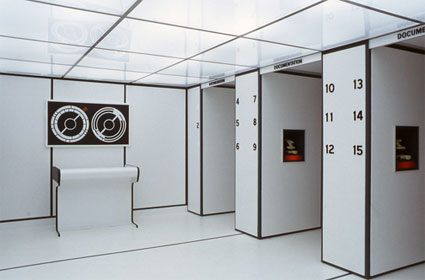
Installation view: Sensorium Part I
Sensorium explores the ways artists address the physical and emotional aspects of our increasing engagement with technology. I missed the exhibition so i found it a bit difficult to engage with the chapter that focuses on the show. Nevertheless i found the book extremely engaging and caught myself adding loads of notes in the margins of the pages or underlying sentences i didn’t want to forget. Starting at page 2 of the book: “The only way to produce a techno-culture of debate at the speed of technological innovation itself is to take up these technologies in the service of aesthetics. Aesthetic contemplation buys us time and space.” Not bad for a start.
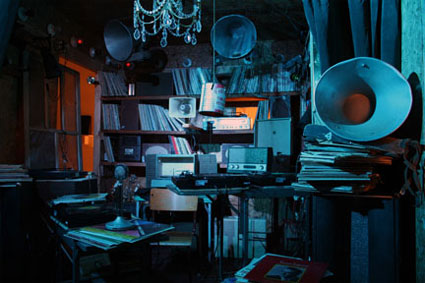
Janet Cardiff and George Burns Miller, Opera For A Small Room, interior, 2005. Photo by Markus Tretter
After an essay by Jones on “The Mediated Sensorium”, the book includes curatorial essays and artists statements on each works participating to the Sensorium exhibition. Artists includes Mathieu Briand, Yuko Hasegawa, Janet Cardiff and George Bures Miller, Ryoji Ikeda, Bruce Nauman, Sissel Tolaas, etc. But also François Roche and R&Sie(n) which means that i have to contradict the statement above about my lack of interest for an exhibition i have not seen.
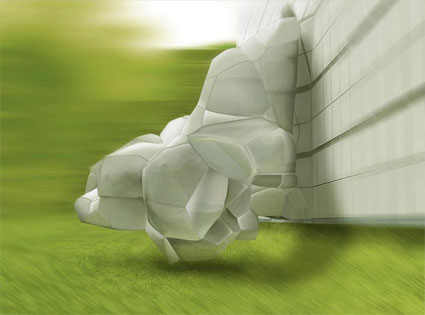
In his contribution to the exhibition, R&Sie(n) introduced the notion of repulsion and taboo in architecture by proposing the Mi(pi) Bar. Meant to look like a “physical secretion” from I.M. Pei’s Wiesner Building where the Visual Arts Center List resides. Mi(pi) Bar is in fact a tearoom in which people drink tea made using their own recycled urine. The outer shape of the tea room is based on the forms of bubbles produced in urination.

The project was never executed but it certainly sparkled some debate. Will knowledge of the tea origin create repulsion, paranoia? Will it change how water seems to taste? After all, rumor has it that from 2009, astronauts will drink their own urine, sweat, and even rat pee recycled and purified by a high-tech machine. In her essay about the project Jane Farver recalls that although clean water is a readily commodity on the MIT campus, it comes at a great expense as the majority of the state’s lakes, rivers and estuaries have pollution problems.
The chapter worth its weight in gold is the Abecedarium, a series of 36 essays which will bring you from the most mundane (an essay on the yuck factor!) to the most unexpected (Turner’s paintings) entries to a re-thinking of our sensory relationship with technology.
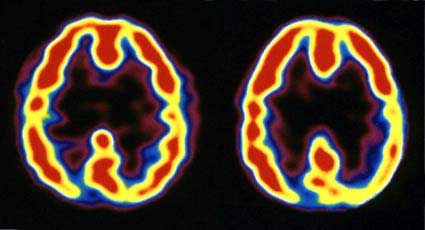
Image discover magazine
Starting with “Air” where Bruno Latour explains how WW1 soldiers realized that air shouldn’t be taken for granted when chlorine gas was thrown at them in Ypres; Michael Bull writes about society’s ipodization in “auditory”; Caroline Jones investigates the increasingly porous boundaries between the biological and the mechanical in “biomimetics”; Chris Csikszentmihalyi draws our attention to the central role that “Control” plays in technology; in “Corpus” Stephen Wilson campaigns for the involvement of art in biological research; Constance Classen wrote a fascinating study on the odor of sanctity; i discovered the “Godscans” in Peter Lunenfeld’d essay about Andrew Newberg‘s affirmation that he had uncovered some evidence of the “biology of belief”; Caroline Bassett wrote about how identity theft is giving rise to governmental claims that we need a digital shadow to match our physical bodies; Peter Galison’s “Nanofacture” essay mentions the dimension that art can take in nanotechnology; William J. Mitchell has a fascinating text on the role of camera phones in the development of a new panopticon of networked consumer electronics; Sherry Turkle explores the way mobile phones transport us to the state of a new ether and have given rise to the tethered self; Iroko Kikuchi recalls the culinary and cultural importance in Japan of the umami (the “fifth taste”), etc.
Sensorium is not one of those easy-to-review and flaunt-it-on-your-livingroom-table glossy volumes that you flip through more than you read. It’s solid, it has depth, historical knowledge and a 360 degrees perspective of what notions related to “embodied technology and the technologized body” mean and involve.
More images of the exhibition.
Image on the homepage: Sissel Tolaas whose contribution to Sensorium was an to embed synthesized human sweat pheromones into the white paint on the gallery’s walls in order to give visitor an idea of what the “smell of fear” is.


















